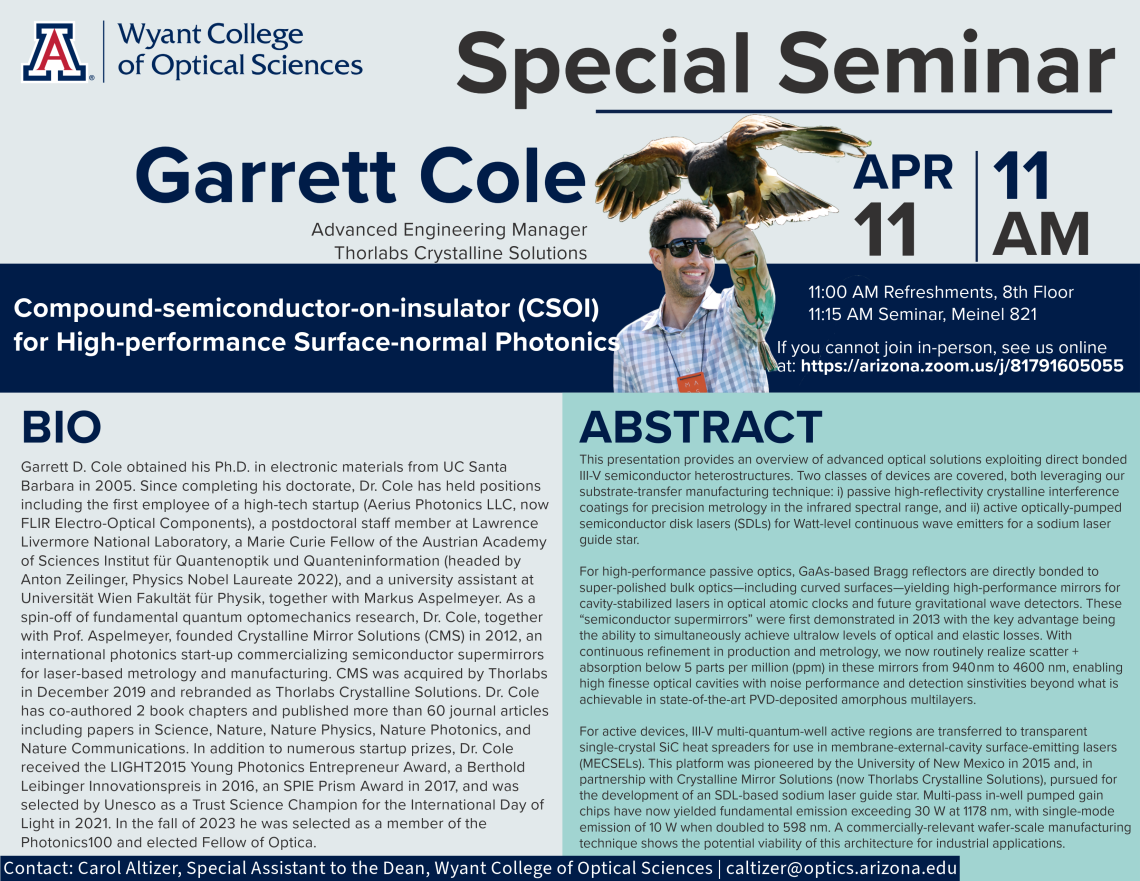
When
Where
Title
Compound-semiconductor-on-insulator (CSOI) for High-performance Surface-normal Photonics
Abstract
This presentation provides an overview of advanced optical solutions exploiting direct bonded III-V semiconductor heterostructures. Two classes of devices are covered, both leveraging our substrate-transfer manufacturing technique: i) passive high-reflectivity crystalline interference coatings for precision metrology in the infrared spectral range, and ii) active optically-pumped semiconductor disk lasers (SDLs) for Watt-level continuous wave emitters for a sodium laser guide star.
For high-performance passive optics, GaAs-based Bragg reflectors are directly bonded to super-polished bulk optics—including curved surfaces—yielding high-performance mirrors for cavity-stabilized lasers in optical atomic clocks and future gravitational wave detectors. These “semiconductor supermirrors” were first demonstrated in 2013 with the key advantage being the ability to simultaneously achieve ultralow levels of optical and elastic losses. With continuous refinement in production and metrology, we now routinely realize scatter + absorption below 5 parts per million (ppm) in these mirrors from 940 nm to 4600 nm, enabling high finesse optical cavities with noise performance and detection sinstivities beyond what is achievable in state-of-the-art PVD-deposited amorphous multilayers.
For active devices, III-V multi-quantum-well active regions are transferred to transparent single-crystal SiC heat spreaders for use in membrane-external-cavity surface-emitting lasers (MECSELs). This platform was pioneered by the University of New Mexico in 2015 and, in partnership with Crystalline Mirror Solutions (now Thorlabs Crystalline Solutions), pursued for the development of an SDL-based sodium laser guide star. Multi-pass in-well pumped gain chips have now yielded fundamental emission exceeding 30 W at 1178 nm, with single-mode emission of 10 W when doubled to 598 nm. A commercially-relevant wafer-scale manufacturing technique shows the potential viability of this architecture for industrial applications.
Bio
Garrett D. Cole obtained his Ph.D. in electronic materials from UC Santa Barbara in 2005. Since completing his doctorate, Dr. Cole has held positions including the first employee of a high-tech startup (Aerius Photonics LLC, now FLIR Electro-Optical Components), a postdoctoral staff member at Lawrence Livermore National Laboratory, a Marie Curie Fellow of the Austrian Academy of Sciences Institut für Quantenoptik und Quanteninformation (headed by Anton Zeilinger, Physics Nobel Laureate 2022), and a university assistant at Universität Wien Fakultät für Physik, together with Markus Aspelmeyer. As a spin-off of fundamental quantum optomechanics research, Dr. Cole, together with Prof. Aspelmeyer, founded Crystalline Mirror Solutions (CMS) in 2012, an international photonics start-up commercializing semiconductor supermirrors for laser-based metrology and manufacturing. CMS was acquired by Thorlabs in December 2019 and rebranded as Thorlabs Crystalline Solutions. Dr. Cole has co-authored 2 book chapters and published more than 60 journal articles including papers in Science, Nature, Nature Physics, Nature Photonics, and Nature Communications. In addition to numerous startup prizes, Dr. Cole received the LIGHT2015 Young Photonics Entrepreneur Award, a Berthold Leibinger Innovationspreis in 2016, an SPIE Prism Award in 2017, and was selected by Unesco as a Trust Science Champion for the International Day of Light in 2021. In the fall of 2023 he was selected as a member of the Photonics100 and elected Fellow of Optica.
